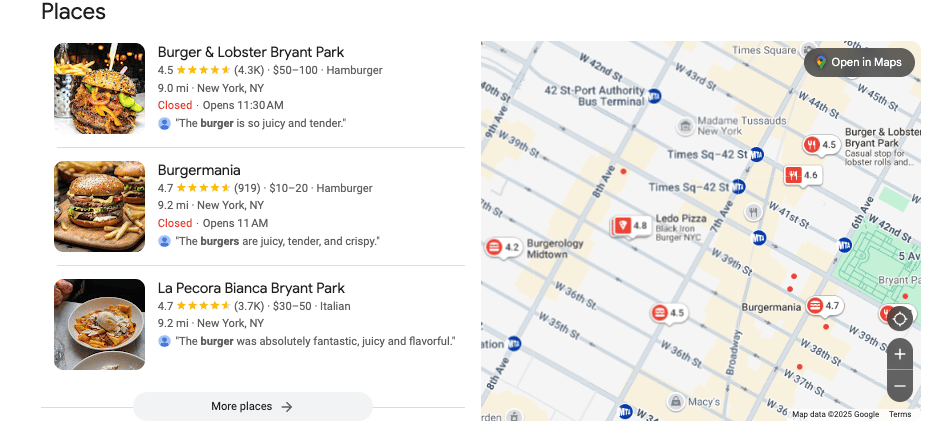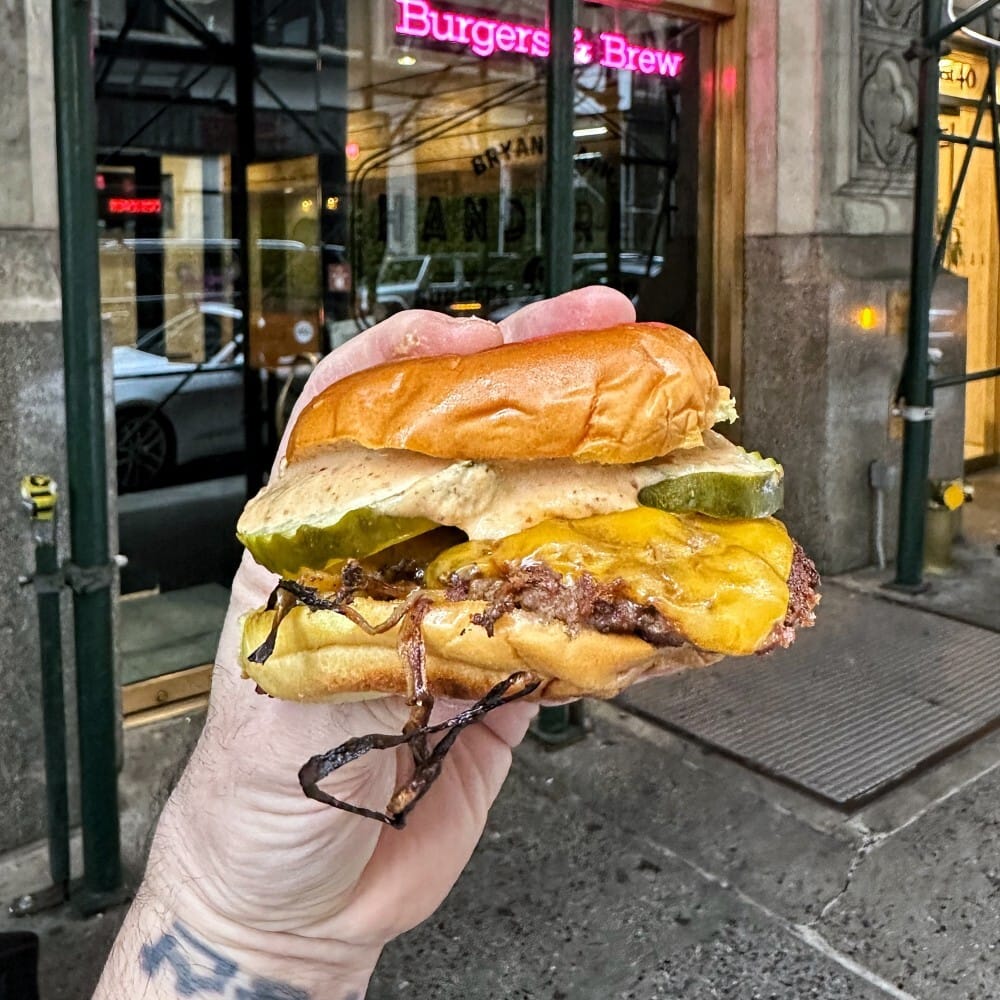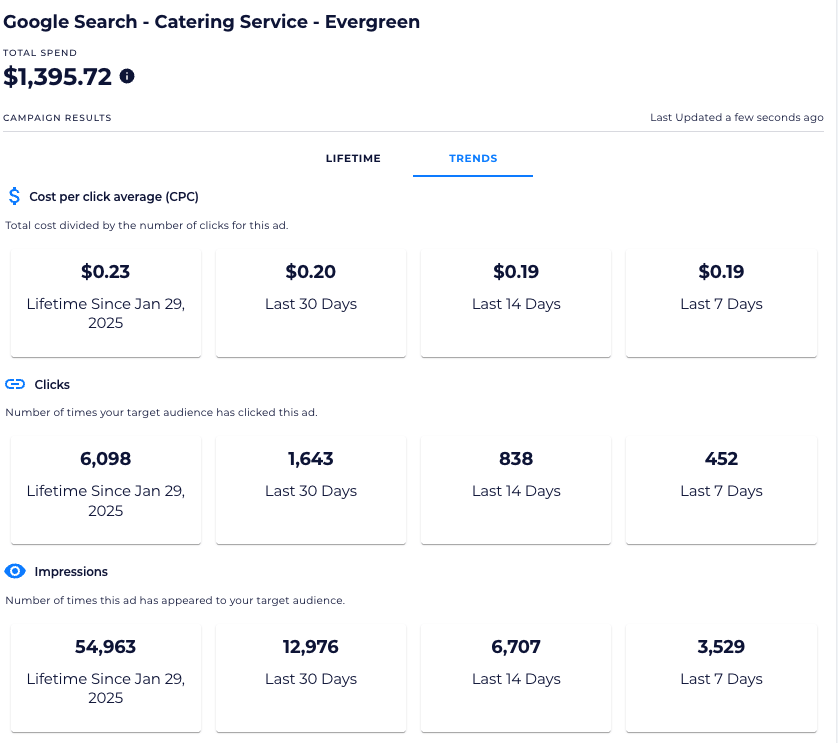Restaurant marketing is hard.
Best practices change constantly, and sometimes I’m not even sure the people at these platforms understand how their own algorithms work—so how are we supposed to keep up?
If it feels like I start a lot of blog posts this way, you're not wrong.
But there’s a reason: I want you to know that I face the same challenges you do. I’m in the trenches, trying to figure this out alongside you. And when I learn something that works? I share it.

Let’s talk about Google—and specifically, Google Search Ads for restaurants.
About two-thirds (if not more) of your website traffic should be coming from Google. I don’t need to sell you on why Google matters. That stat alone should set the tone.
Your goal is to optimize for every relevant click you can get. One smart, scalable way to do that is by running Google Search Ads.
I tell clients all the time: "If we absolutely need to be at the top of relevant searches, we should pay for it."

Time to check my Google ads ....
The good news? When done right, Google Search Ads are pretty affordable. Many of my clients are seeing clicks for less than $0.25—well below the industry benchmark of $1.25.
Let me ask you this: If someone searched “best [insert menu item] near me” and your restaurant was a fit, would you pay 25 cents to be the one they clicked while standing on a sidewalk deciding where to eat?
You don’t have to answer. You already know.

So—how do you optimize Google Search Ads at the location level to get the most clicks for the least amount of money?
I don’t have every answer (or I’d be running a full-blown “done-for-you” Google Ads agency), but here’s what we’re doing at my restaurant and what my clients are using to win:
Google Search Ads for Restaurants: Optimization Framework
BUDGETING
Let’s start here—since everyone always asks.
Begin at $5/day per location
Increase when either:
I like to say: Buy when the buying is good.
A daily budget of $10–$15 per location is strong for evergreen ads.
How do you know if you’ve gone too high? If your CPC suddenly spikes—you may have overbought the market. Increase gradually and monitor performance.

LOCATIONS
Notice I said: per location.
I get asked a lot: “If I have multiple stores in one town/state/region, can I just run a regional ad?”
Yes—you can. Should you? Absolutely not.
It’s tempting to simplify things, but it’s not the optimal play. If a store has a unique need but doesn't have its own ad, there’s no way to tailor performance. You’re flying blind.
If your regional ad helps another location? Great. As long as your online ordering provider (first- or third-party) routes the order correctly, everyone wins.
But take the time to set ads up per store. Google Search Ads are evergreen, don’t require creative, and are easy to adjust. Set them up right, and they’ll serve you well.

TARGETING
Start with radius targeting. It’s the easiest way to reach people who live or work nearby.
Match your radius to your delivery zone:
Deliver 2 miles? Set a 2-mile radius.
Deliver 10 miles? Use a 10-mile radius.
Don’t overextend—you’re not trying to win a market that won’t convert.
If you’re in a geographically weird spot—like next to water, a mountain, or a dead zone—or your stores overlap, switch to ZIP code targeting. Pull ZIPs from:
Third-party order data
Your POS
Your CRM or loyalty system

KEYWORDS
Some marketers call this ballot-stuffing. I call it the Blitzkrieg approach.
If you're a fried chicken spot with no salads on the menu, don’t bid on “salad near me.” Make sense?
Start here:
Go to your Google Business Profile (GBP) > Performance tab
Look at the top 20 terms you're ranking for already
Use those. Every one of them.
Also include terms for initiatives you want to grow—like catering or private parties.
How do you know you’ve gone too granular? If you’re an ice cream shop that offers walnuts as a topping, you don’t need to bid on “walnuts near me.”
Stick to: “Ice cream,” “ice cream sundae,” “ice cream shop,” “best ice cream.”
Use your common sense. You’ll know.

GBP CONNECTION
This one gets missed all the time: Ad local extensions to your search ads by connecting your Google Business Profile
"Location extensions are a feature in Google Ads that allows you to show business location data – such as your address – with your ads to increase the likelihood of someone taking action." (Thanks Invisible PPC!)
Don’t skip it. It improves ad visibility, trust, and performance.
Need help? Google how to do it. (Yes, that joke writes itself.)

BUY YOUR BRAND NAME
Three solid reasons to buy your own name as a keyword:
Brand protection. Your competitors can bid on your name. Beat them to it.
Search hijacking. Sometimes Google suggests other restaurants when people search yours. (More often than you’d think.)
Lower your overall CPC. Buying your brand name is usually your cheapest keyword—and it lowers your average CPC across the board.
I believe (though unconfirmed) that the more clicks you get, the more Google rewards you with cheaper impressions. So buy the clicks that help the algorithm work in your favor.

BONUS: CATERING ADS
Is catering important to your business?
Run a separate Google Search Ad for it.
Yes, include catering keywords in your general ads. But also give it its own campaign.
We’ve seen catering-focused ads outperform regular brand ads on CPC and conversions.
You’d pay $0.25 every time for a user who searches “catering near me” and lands directly on your catering page, right?
If that campaign outperforms your general ad? Shift budget. And remember—catering customers often become repeat guests.

That’s my framework—including all the best practices I currently know and have tested.
Thanks to Josie Franske from My Burger for the inspiration and assist!
Have questions? Ask. Got tips? Share them below.
Need help with any of this? Shoot me an email: [email protected]
– Rev Ciancio
WHAT DOES REV DO?
I help restaurants build guest marketing programs.
I help hospitality tech companies with lead generation and content marketing.


